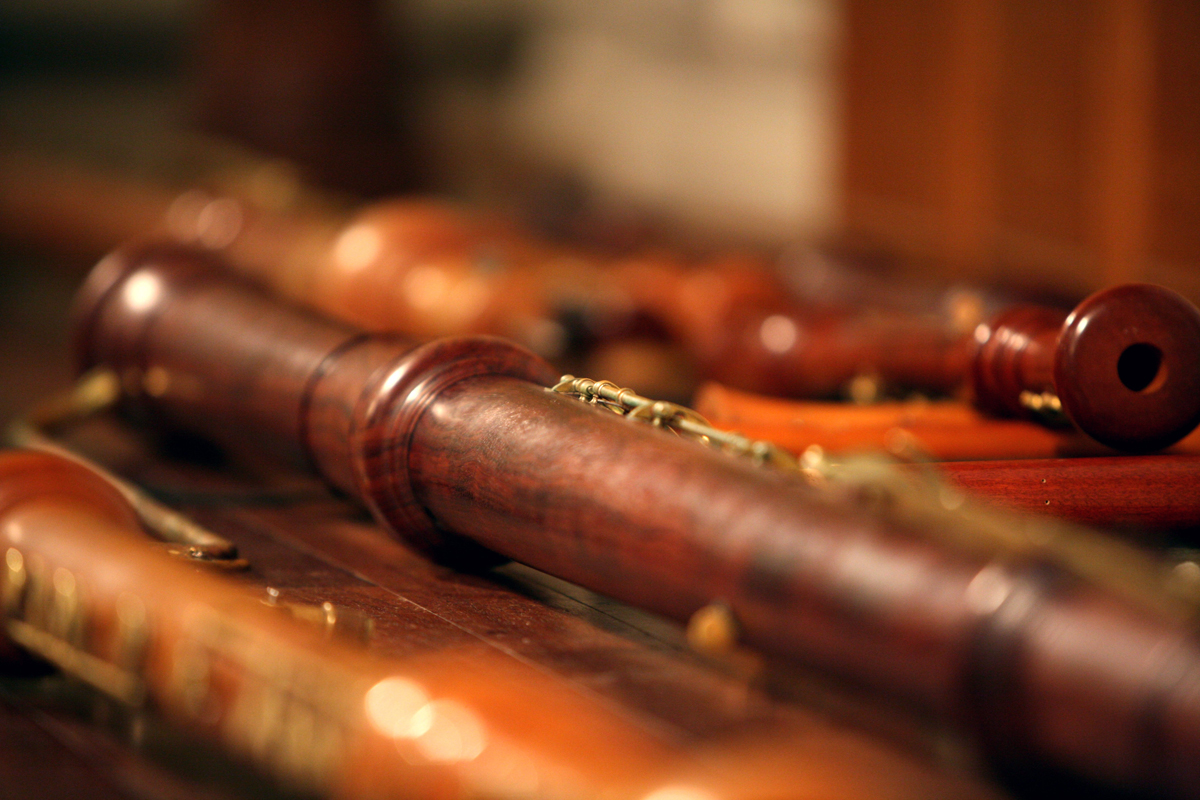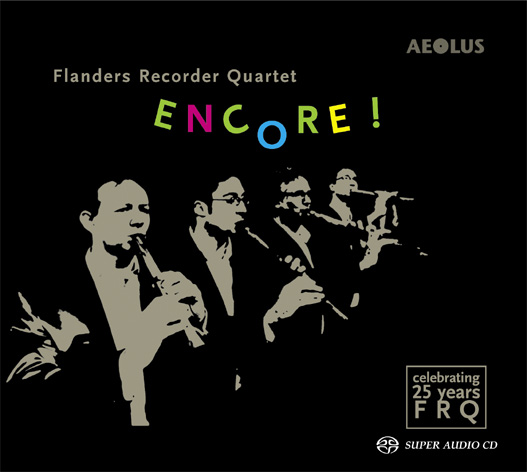INSTRUMENTS
'Virdung' consort by Adrian Brown
Unfortunately, no recorders have come down to us from before the sixteenth century. For works from 1520 and earlier, the Flanders Recorder Quartet makes use of a very rare collection of instruments, made by the Amsterdam-based maker Adrian Brown. He has provided us with a small cylindrical consort based on the woodcut illustrations in the treatise of Sebastian Virdung (Musica getuscht und angezogen, 1511). Having this restricted basis of surviving instruments and using the woodcuts as a template, he constructed a speculative recorder consort at pitch a'=520 (which is the pitch of the oldest still-sounding organs in northern Italy) consisting of a basset in f, tenors in c and altos in g'. These recorders in walnut have a quite peculiar sound and an interesting and colourful articulation, which best suits this early repertoire.
2 altos in g'
3 tenors in c
1 bass in f
Baroque consort by Friedrich von Huene
This set of large baroque recorders was built between 1990 and 1995 by the Boston-based recorder maker Friedrich von Huene. The smaller instruments are personal favourites of the players, collected from all over the world, and copied from original models in various wood types. The pitch of baroque recorders is a'=415, being a semi tone below the modern concert pitch. Our set consists of many types, from sopranino through soprano, alto, voice flute, tenor, bass, great bass up to the man-high contrabass in F, of which there are only three models in the world.
1 sopranino in f"
1 soprano in c
1 alto in f'
2 tenors in c'
1 basset in g
1 bass in C
1 Contrabass in FF
Bassano Consort by Tom Prescott
There are around 200 surviving original recorders from the period 1500-1650, a time we could describe today as being the golden age of the instrument. It was the only period in the recorder's history when it was considered as a serious musical instrument and when families of recorders were played in consort, principally to perform vocal music. Henry VIII (1491-1547) presumably was so enchanted by the instrument that he arranged for his agents to persuade members of the celebrated Bassano family to emigrate from Venice to England to play and make wind instruments at his court. An inventory of Henry's collections made after his death in 1547 notes 76 recorders among his many musical instruments. Another example of the popularity of the recorder at this time is found in a 1531 inventory of the Antwerp town musicians, which lists no fewer than 28 recorders. Almost a fifth of these surviving recorders are found today in the Kunsthistorisches Museum in Vienna, but originate from the d'Este collection in the region of Padua.
1 soprano in c"
3 altos in g'
4 tenors in c'
3 bassets in g
3 bassets in f
2 basses in C
1 bass in F
Ocarina consort by John Langley
(NOT FOR SALE)
The ocarina is an instrument belonging to the family of the vessel flutes. Their body is, unlike a recorder, shaped as an eg of a bowl. The first ocarina’s were found in Mexico and are dated around 1000 before Christ. The ocarina is, acoustically, based on the principle of the Helmholtz resonator; this means that the pitch varies with the volume of the instrument and the cross-sectional area of holes open. Exactly which holes are open doesn't make any difference to the pitch you get, so long as the open area is the same. So there are more opportunities for alternate fingerings than with most other woodwinds. The Ocarina consort that is used by the Flanders Recorder Quartet is made by John Langley in the United Kingdom. He makes his ocarinas of a white clay, and glazes them with a beautiful semi-transparent blue-green glaze.
1 micro in d”’
1 sopranino in g”’
2 sopranos in g”
2 altos in d’
3 tenors in g’
3 basses in d
4 Great Basses in G
2 Contrabasses ‘Pregnaphone’ in GG
Recorders not belonging to a set
All the instruments that are not made as a consort, as a set, are personal belonging of the members of the Flanders Recorder Quartet. They represent the personal views on instruments and styles. This instrument parc is constantly changing and at the moment consists of the following instruments, being used in the context of the Flanders Recorder Quartet:
1 Baroque soprano in c" by Takeyama
2 Terton sopranos in c" by Hans Schimmel
1 Terton soprano in c" by Fred Morgan
2 Baroque altos in g' by Peter van der Poel
2 Bressan altos in f' by Hans Schimmel
1 Bressan alto in f' by Adri Breukink
4 Denner altos in f' by Adrian Brown
1 Stanesby alto in f' by Fred Morgan
1 Bressan alto in f' by Fred Morgan
1 Denner alto in f' by Fred Morgan
1 "voice flute" in d' by Hans Schimmel
1 "voice flute" in d' by Patrick von Huene
1 "voice flute" in d' by Adrian Brown
1 "voice flute" in d' by Fred Morgan
2 Basses in f by Yamaha
1 Soprano "van eyck" in c" by Fred Morgan
2 Soprano2 "van eyck" in c" by Bob Marvin
1 Rosenborg soprano in c" by Adri Breukink
1 Soprano in c" "ganassi" by Adrian Brown
1 Alto in f' "bassano" by Bob Marvin
2 Altos in g' "ganassi" by Adrian Brown
1 Alto in g' "ganassi" by Sigerahu Hirao
1 Tenor in c' "ganassi" by Peter van der Poel
1 Tenor in c' "wollick" by Bob Marvin





![5 [five] 5 [five]](https://flanders-recorder-quartet.be/pictures/cd/Coverentwurf FRQ5 S3 RGB Full.jpg)
